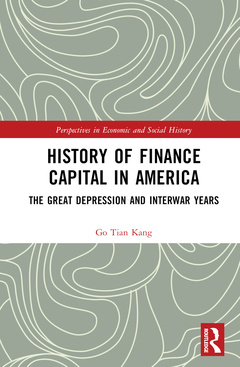History of Finance Capital in America The Great Depression and Interwar Years Perspectives in Economic and Social History Series
Auteur : Kang Go Tian

Go details through institutional analysis how major financial institutions (including banks and insurance companies), industries, and the U.S. government behaved and linked with each other during the Great Depression and Inter-War period.
Drawing on data that has not been widely used since the late thirties ? including congressional hearings, financial data, and government reports concerning economic concentration in the Depression Era ? Go presents a general picture of American finance capital on the eve of World War Two. He details the emergence of important new financial-industrial powers in 1920?s that challenged the Wall Street?s established order on the eve of Great Depression, the response of the Wall Street?s finance capital to the challenge, and its renewed dominance as well as the growing community of interests between finance and industry under the Depression. He also points out the role of Wall Street?s finance capital in financing the Reconstruction Finance Corporation (RFC) in 1932, the New Deal, and the emerging war economy.
With its coverage of primary sources, this book will interest researchers and advanced undergraduate students taking American history, political science, and institutional economics.
Contents
PREFACE
Chapter ⅠDe-concentration after World War I (part 1)
—The emergence of new financial-industrial powers
Ⅰ The Rise of New Industries
Ⅱ The Formation of New Financial-Industrial Powers
1. The Regional Financial-Industrial Powers
2. The Investment Bankers and their Investment Trusts
3. The Industrial Capitalists become Bankers
Chapter ⅡDe-concentration after World War I (part 2)
—The response of Wall Street financial-industrial powers
Ⅰ Morgan-First National Group
Ⅱ National City Group
Ⅲ Chase Group
Chapter Ⅲ The Renewed Dominance of Finance Capital under the Depression
Ⅰ The Dominance of Finance Capital
1. Formation of the stock pool
2. Leading the bond syndicates
3. Concentration of bank loans
4. The Massive withdrawal of brokers’ loans and its consequences
Ⅱ The Fall of the New Financial-Industrial Powers
1. The elimination of powerful competitors in the financial center
2. The fall of regional powers
Ⅲ Industrial Concentration Following the Crash
1. Public utilities (power and gas)
2. Electrical equipment
3. Motor Cars
4. Oil
5. Steel
6. Motion Pictures
7. Newsprint
Chapter Ⅳ The Growing Community of Interests
1. Public Utilities
2. Petroleum
3. Iron and Steel
4. Automobile sales finance
5. Chemicals
6. Tire
7. Tobacco
8. Distilleries
9. Canneries
10. Paper
11. Motion Pictures
12. Merchandizing
13. Aircraft
14. Shipbuilding
Chapter Ⅴ The New Oligarchy
Ⅰ The Emergence of New Oligarchy
Ⅱ The Morgan-First National Group
1. The Four Morgan-First National Banks
2. The Three Big Insurance Companies
3. The Two Investment Banking Firms
Ⅲ The Rockefeller Group
1. Chase National Bank
2. Metropolitan Life and Equitable Life
3. The First Boston Corporation and Rockefeller’s subordinate allies in investment banking
Ⅳ National City Group
Ⅴ Wall Street’s Growing Influence over the Regional Groups
1. The Chicago banks’ growing dependence on the Wall Street financial powers
2. Subordination of Mellon to Rockefeller
3. Cleveland becomes a satellite of Wall Street
4. The new alliance between Boston and Rockefeller
Chapter Ⅵ Finance Capital in Federal Finance
Ⅰ Financing the Reconstruction Finance Corporation (RFC)
Ⅱ Financing the New Deal Program
Ⅲ Supporting the emerging War Economy
APPENDIX
SELECTED BIBLIOGRAPHY
INDEX
GO Tian Kang is Emeritus Professor of Chuo University, Japan. He is the author of American Commercial Banks in Corporate Finance 1929-1941 and has contributed numerous articles to economic journals.
Date de parution : 04-2024
15.6x23.4 cm



